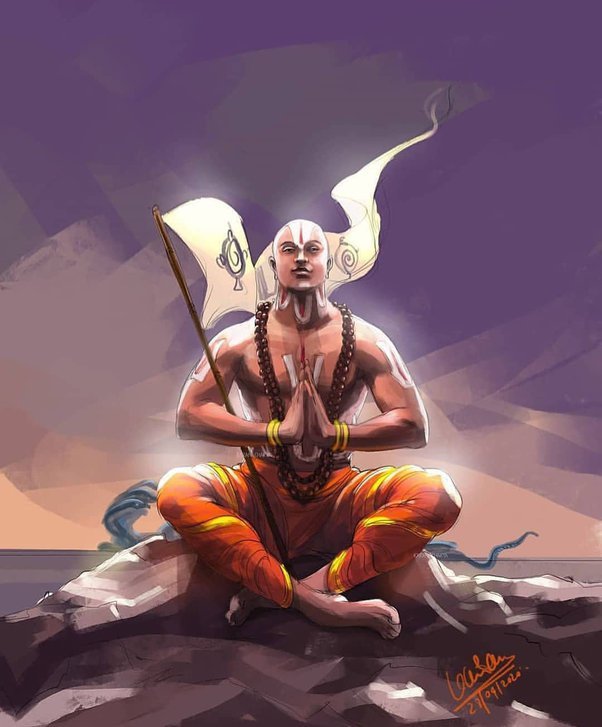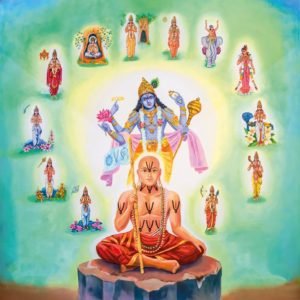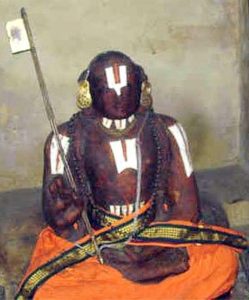What is Sri Ramanujacharya’s ‘Siddhanta’?


Barring Bhaskara’s Bhedabheda ( identity – in – difference ) interpretation of Vedanta Sutras, Ramanuja’s was the first comprehensive criticism of the Vedanta as expounded by Sankara some three centuries before him.
Among all the teachers of this devotional brand of Vedanta, Ramanuja is the one whose metaphysical genius rivals that of Sankara himself. He was a master of vedic lore and methodology of arguments and exposition. While in his subsidiary works he relies on the devotional writings of his school of Vaishnavism, in his main work the Sri Bhasya or the commentary on Vedanta Sutras of Badarayana, he exhibits himself to be a pure Vedantin, that is follower of Upanishadic doctrine of Brahman, which of course according to him is identical with Narayana – the Ultimate Reality.
Upanishadic Brahman is the unity which comprehends in Himself all the diversities of common experience and yet remains unaffected and unlimited by them. Sankara establishes that unity by reducing all diversity into a mere appearance like a snake superimposed on a rope in semi-darkness. According to Sankara the darkness of ignorance is the cause of of illusory presentation of multiplicity. All the time multiplicity is perceived it is not there, and the unitary consciousness has remained unchanged. On the light of knowledge arising, the illusory presentation disappears without leaving anything beyond the Non-dual One, which was always there unchanged as the substratum. He thus achieves unity of all existence and the unchangeableness and unaffectedness of Brahman. this achievement leaves many problems unsolved and creates many others to be solved. he however gives a prima-facie reality to the world of diversity from the practical point of view ( Vyavaharika Satta ) , only to deny it absolutely in the end. An unmodified and attribute less Consciousness is the Ultimate Reality. Reality has thus for Sankara has two tiers – the apparently real and the truly real.
Ramanuja is totally hostile to this Advaitic interpretation of the unity proclaimed by this brand of Vedanta. Unity is not the sublation of all diversity but the subordination of diversity into unity.
He never used the term Visistadvaita anywhere. Just as Sankaras doctrine came to be known as Kevaladvaita later, this term was later used to differentiate it from other systems of Advaita. The term Visistadvaita is often translated as qualified non-dualism. Scholars feel ‘Non duality of the qualified whole’ is a better translation. Von Buitenin elaborated this as ‘ unity of the universe’s spiritual and non-spiritual substances with, and in, a God whom they modify as his body’ .A more compact translation is ‘Pan Organistic Non Dualism’.
In this system the world is ultimately true, God is ultimately true, the Jiva is ultimately true, and the liberation from bondage is also factually true. Thus in effect it is a totally realistic theism in which God and the Absolute are one and the same. The non-dual all-inclusive qualified Whole is the Brahman of the Vedanta according to Ramanuja.
While this metaphysical framework is established and argued with relentless logic and philosophical methodology of Vedantic tradition, Ramanuja’s system gets flesh and blood by his devotional ideologies of the passionate devotees of Lord Visnu ( the Alvars ) of Tamil land. Thus Ramanuja’s Vedanta becomes philosophical Vaisnavism. While he is strict Vedantin in his methodology and way of spiritual exegesis, he identified the Upanisadic Brahman as Visnu- Narayana, this is where the philosophy turns to religion.
Ramanuja’s mission in life was to effect a rational and natural mingling of the rapturous devotion of the Alvars with the Upanishadic quest of ontological and unifying ground of the changing world of the many.

Sankaracarya interprets the Upanishadic doctrine of the Absolute as the Non-Dual being in whom the world of many is a mere appearance ascribed by ignorance and not actually existing. When ignorance is overcome by proper metaphysical insight, the aspirant realizes that what he considered as ‘I’ is really Absolute Brahman into whom the apparent world and its God too resolve. Ramanuja totally differs from such interpretation of the Upanishadic doctrine which militates against the ultimacy of God and the supremacy of devotion. He severely criticizes the theory of Ignorance and the compartmentalisation of Reality into Paramartha (ultimate) and Vyavaharika (relative/practical).
There is no answer from the Advaitin to the locus of Ignorance. If it is Brahman, Brahman becomes loaded with evil and becomes unworthy as a spiritual goal. If it is Jiva, the same defect persists, as the Jiva in its real nature is one with Brahman according to Advaita. if it is entirely a different category, dualism is the result.
Besides, the Jiva is caused by the Upadhis ( adjuncts ) superimposed on Brahman and these Upadhis are the products of Ignorance. thus Ignorance must precede the Jiva and cannot therefore be conceived as located in it.
Ramanuja directs a devastating attack against the doctrine of a sublatable God who is less than Absolute or the Supreme Being, against the theory of Ignorance which is without a definite locus and which cannot be described as existent or non-existent or combination of both, and against compartmentalization of Reality into Paramartha(ultimately real) and Vyavaharika(relatively real).
a.) Ramanuja’s was the first thorough-going and decisive criticism of the Advaita of Sankara characterised by an attribute less Brahman as the Supreme Reality and the doctrine of nescience which has no positive location or existence, though his protest had already been made earlier by Bhaskara, the propounder of Bheda-Bheda philosophy.
b.) Ramanuja’s system of thought was the store house from which all later Bhakti teachers drew liberally, making only some limited changes to suit their tradition of theology
c.) he was the first to propound a philosophy of theism in which God is the Absolute and the Absolute is God – in fact to obliterate the distinction between these two that Advaitism had projected
d.) He gave to Indian thought a God who includes everything in Himself yet transcends the world of becoming, and who according to his Sarira-Sariri doctrine is the indweller of the cosmos as a whole and of every bit of it
e.) His theory presents God as transcendent in nature and majesty but at the same time easily accessible to those who want Him in truth.
f.) The God we get in His doctrine is a being who has Truth, Knowledge, Bliss, purity and Infinity as his inherent nature, who has Omniscience, omnipotence, lordship, immutability, Splendor, Generosity, Compassion etc… as countless auspicious qualities; who is a great creator; who has aform that is archetypal and the quintessence of beauty and attractiveness; who has a Trans-Natural Realm of Spiritual Stuff where He is present always with constant attendants and the liberated Jivas; who bears the supreme name of Narayana; and who , being the indweller of all beings including Deities, constitutes the only ONE who is worshipped and who can grant liberation from the trammels of Samsara.
(Points taken from Swami Tapasyananda)
Ramanusa Idhen Vinnappame !!!

DISCLAIMER: The author is solely responsible for the views expressed in this article. The author carries the responsibility for citing and/or licensing of images utilized within the text.
